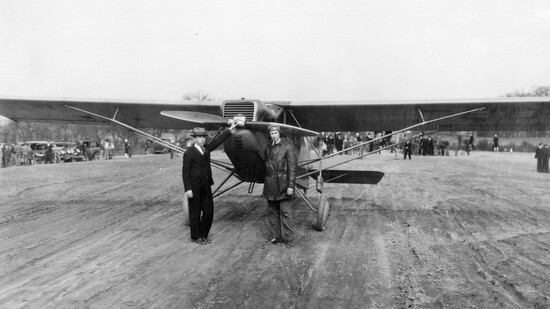When checking the status of a flight, whether you are heading out of town or waiting on a family member or friend to arrive, it can be handy to know the three-digit code for the Knoxville airport. Those three letters—TYS—actually tell an interesting little story.
TYS stands for Tyson, or more specifically, McGhee Tyson, for whom the airport is named.
The Knoxville airport is a bit of a puzzle because it’s not even located in Knox County—and most people have no idea for whom it is named.
First developed in the West Knoxville community of Bearden just after World War I, the first local airport was known as Aviation Field (later Bearden Field) in the area we would generally recognize on the south side of Sutherland Avenue where the UT ball fields are today. The developers, Dan Chambliss and his son George, lived nearby. Dan was an early advocate of the automobile and served as a president of the Knoxville Automobile Association that promoted driving and good roads.
Aviation Field witnessed the landing of the impressive Airship Knoxville, co-piloted by George Chambliss, after a 46-hour flight from Long Island, N.Y.–and flying stunts such as local prizefighter Tiger Toro walking along the wings of a biplane in mid-air.
By the mid-late 1920s, despite being lengthened, the continuing sophistication of new planes and passenger flight demand meant that Aviation Field’s take-off and landing strip (roughly 800 x 30 feet), managed by the Knox Aero Corporation, was becoming inadequate for increasing air traffic.
When the western part of the airstrip was developed for residential use, the facility expanded to encompass land where the Tennessee National Guard and West High School are today.
In 1929, the City of Knoxville purchased Knox Aero Corps’ stake in the operation, expanding the runway to 2,000 feet long, and became our first municipal airport, known initially as the “Port of Knoxville.”
Back in the early 1920s, Brigadier-General Lawrence Davis Tyson (a prominent lawyer, industrialist, newspaper publisher, speaker of the Tennessee House, and U.S. Senator) and his wife Bettie McGhee offered to donate a parcel of land on Kingston Pike near the university to the city for use as a public park in memory of their son, Charles McGhee Tyson.
Known by his middle name, McGhee Tyson grew up in Knoxville and had studied at St. Paul’s School in Concord, N.H., and graduated from Princeton University. He returned to Knoxville for several years and played a lot of golf, often at Cherokee Country Club. He joined the United States naval reserve flying corps in 1917 and saw active service in World War I the following year. But before that, at 29 years of age, he flew back to New York and married his sweetheart that summer.
On October 11, 1918, within weeks of the armistice marking the end of the war, his plane experienced a mid-air collision with another aircraft off the northeast coast of England. He was reported as “missing, probably drowned.”
At the time, Brig. Gen. Tyson, had been stationed with the 59th Brigade, 30th division of the American Expeditionary Forces in France. At the cessation of the war, Tyson traveled to England where he learned that his son’s body had been recovered. He assisted with plans to escort it home to Knoxville where he was to be buried at Old Gray Cemetery. Today, McGhee Tyson’s grave, and those of his parents, are accompanied by the tallest obelisk in the cemetery.
What eventually became Tyson Park took almost a decade to be developed—at one point it had been suggested that it could be sold to fund the expansion of the new municipal airport in Bearden. Although Brig. Gen. Tyson died in 1929, his widow, Bettie, maintained that the land donation was conditional on having the park, and the new airport, be named after their son.
Knoxville City Council finally accepted the property for Tyson Park and approved the new name of the city airport, McGhee Tyson, in November 1929.
Within a few years, the ever-increasing demand for passenger air travel meant that even the city airport in Bearden, landlocked within suburban Knoxville, was no longer geographically positioned to handle further growth. A new location off the new Alcoa Highway (opened in 1939), was secured with substantial funding through the Works Progress Administration, a New Deal agency. Potential renaming, though, caused some controversy.
Several names were reported in the press: Knoxville airport, Knox-Blount airport, Knoxville-Alcoa-Maryville airport (the letters K-A-M. would have made an obvious airport code), and Great Smoky Mountains airport. The latter came in the wake of enormous interest in the recently opened Great Smoky Mountains National Park (officially designated in 1934, and dedicated in 1940). City boosters in Alcoa and Maryville, as well as park movement leaders, including Col. David Chapman and Carlos Campbell, advocated for “Great Smoky Mountains Airport.”
Finally, in early 1937, Knoxville city manager George Dempster stated that the city was bound by the original terms of the deed for Tyson Park, and rather than risk losing that tract as a city park maintained that the new airport, even though it was to be built in Blount County, should still be named McGhee Tyson airport. And to this day, that name remains, as does the three-digit airport code, TYS.
ABOUT KHP
The nonprofit Knoxville History Project tells the city’s stories, focusing on those that have not been previously told and those that connect the city to the world. Donations to support the work of the Knoxville History Project, an educational nonprofit, are always welcomed and appreciated. Learn more at KnoxvilleHistoryProject.org
The history of Aviation Field is told in Historic Bearden: The 200-Year History of Knoxville’s Fourth Creek Valley by Jack Neely and Paul James. Look for the title at the East Tennessee History Center, Union Ave Books, and online at KnoxvilleHistoryProject.org
